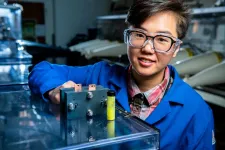(Press-News.org) HOUSTON - (May 20, 2021) - It's always good when your hard work reflects well on you.
With the discovery of the giant polarization rotation of light, that is literally so.
The ultrathin, highly aligned carbon nanotube films first made by Rice University physicist Junichiro Kono and his students a few years ago turned out to have a surprising phenomenon waiting within: an ability to make highly capable terahertz polarization rotation possible.
This rotation doesn't mean the films are spinning. It does mean that polarized light from a laser or other source can now be manipulated in ways that were previously out of reach, making it completely visible or completely opaque with a device that's extremely thin.
The unique optical rotation happens when linearly polarized pulses of light pass through the 45-nanometer film and hit the silicon surface on which it sits. The light bounces between the substrate and film before finally reflecting back, but with its polarization turned by 90 degrees.
This only occurs, Kono said, when the input light's polarization is at a specific angle with respect to the nanotube alignment direction: the "magic angle."
The discovery by lead author Andrey Baydin, a postdoctoral researcher in Kono's lab, is detailed in Optica. The phenomenon, which can be tuned by changing the refractive index of the substrate and the film thickness, could lead to robust, flexible devices that manipulate terahertz waves.
Kono said easy-to-fabricate, ultrathin broadband polarization rotators that stand up to high temperatures will address a fundamental challenge in the development of terahertz optical devices. The bulky devices available until now only enable limited polarization angles, so compact devices with more capability are highly desirable.
Because terahertz radiation easily passes through materials like plastics and cardboard, they could be particularly useful in manufacturing, quality control and process monitoring. They could also be handy in telecommunications systems and for security screening, because many materials have unique spectral signatures in the terahertz range, he said.
"The discovery opens up new possibilities for waveplates," Baydin said. A waveplate alters the polarization of light that travels through it. In devices like terahertz spectrometers used to analyze the molecular composition of materials, being able to adjust polarization up to a full 90 degrees would allow for data gathering at a much finer resolution.
"We found that specifically at far-infrared wavelengths -- in other words, in the terahertz frequency range -- this anisotropy is nearly perfect," Baydin said. "Basically, there's no attenuation in the perpendicular polarization, and then significant attenuation in the parallel direction.
"We did not look for this," he said. "It was completely a surprise."
He said theoretical analysis showed the effect is entirely due to the nature of the highly aligned nanotube films, which were vanishingly thin but about 2 inches in diameter. The researchers both observed and confirmed this giant polarization rotation with experiments and computer models.
"Usually, people have to use millimeter-thick quartz waveplates in order to rotate terahertz polarization," said Baydin, who joined the Kono lab in late 2019 and found the phenomenon soon after that. "But in our case, the film is just nanometers thick."
"Big and bulky waveplates are fine if you're just using them in a laboratory setting, but for applications, you want a compact device," Kono said. "What Andrey has found makes it possible."
INFORMATION:
Co-authors of the paper are Rice graduate students Natsumi Komatsu and Fuyang Tay and alumni Saunab Ghosh, Takuma Makihara and Timothy Noe. Baydin is an Attwell-Welch Postdoctoral Fellow of Rice's Smalley-Curl Institute. Kono is the Karl F. Hasselmann Professor in Engineering and a professor of electrical and computer engineering, of physics and astronomy and of materials science and nanoengineering.
The National Science Foundation and the U.S. Department of Energy supported the research.
Read the paper at https://www.osapublishing.org/optica/fulltext.cfm?uri=optica-8-5-760&id=451230.
This news release can be found online at https://news.rice.edu/2021/05/20/thin-is-now-in-to-turn-terahertz-polarization/
Follow Rice News and Media Relations via Twitter @RiceUNews.
Related materials:
Nanotubes line up to form films: http://news.rice.edu/2016/04/04/nanotubes-line-up-to-form-films-2/
Junichiro Kono Laboratory: http://kono.rice.edu
Department of Physics and Astronomy: https://physics.rice.edu
Wiess School of Natural Sciences: https://naturalsciences.rice.edu
Images for download:
https://news-network.rice.edu/news/files/2021/05/0524_TERAHERTZ-1-WEB.jpg
Rice University physicists have made unique broadband polarization rotators with ultrathin carbon nanotube films. The films optically rotate polarized light output by 90 degrees, but only when the input light's polarization is at a specific angle with respect to the nanotube alignment direction: the "magic angle." (Credit: Kono Laboratory/Rice University)
https://news-network.rice.edu/news/files/2021/05/0524_TERAHERTZ-2-WEB.jpg
Ultrathin, broadband polarization rotators are made possible by ultrathin carbon nanotube films developed at Rice University in 2016. The films of highly aligned single-walled nanotubes were first made in 2016. (Credit: Kono Laboratory/Rice University)
https://news-network.rice.edu/news/files/2021/05/0524_TERAHERTZ-3-WEB.jpg
CAPTION: Andrey Baydin. (Credit: Rice University)
https://news-network.rice.edu/news/files/2021/05/0524_TERAHERTZ-4-WEB.jpg
CAPTION: Junichiro Kono. (Credit: Jeff Fitlow/Rice University)
Located on a 300-acre forested campus in Houston, Rice University is consistently ranked among the nation's top 20 universities by U.S. News & World Report. Rice has highly respected schools of Architecture, Business, Continuing Studies, Engineering, Humanities, Music, Natural Sciences and Social Sciences and is home to the Baker Institute for Public Policy. With 3,978 undergraduates and 3,192 graduate students, Rice's undergraduate student-to-faculty ratio is just under 6-to-1. Its residential college system builds close-knit communities and lifelong friendships, just one reason why Rice is ranked No. 1 for lots of race/class interaction and No. 1 for quality of life by the Princeton Review. Rice is also rated as a best value among private universities by Kiplinger's Personal Finance.
At the start of the COVID-19 outbreak, a University of Illinois Chicago researcher conducted a survey asking respondents if they experienced health care delays because of the pandemic. In addition to learning about the types of delays, the study also presented a unique opportunity to capture a historic moment at the pandemic's beginning.
Elizabeth Papautsky, UIC assistant professor of biomedical and health information sciences, is first author on "Characterizing Healthcare Delays and Interruptions in the U.S. During the COVID-19 Pandemic Using Data from an Internet-Based Cross-Sectional ...
During the first phase of the COVID-19 epidemic, New York City experienced high prevalence compared to other U.S. cities, yet little is known about the circulation of SARS-CoV-2 within and among its boroughs. A study published in PLOS Pathogens by Simon Dellicour at Université Libre de Bruxelles, Belgium, Ralf Duerr and Adriana Heguy at New York University, USA, and colleagues describe the dispersal dynamics of COVID-19 viral lineages at the state and city levels, illustrating the relatively important role of the borough of Queens as a SARS-CoV-2 transmission hub.
To better understand how the virus dispersed throughout New York ...
Ancient pollen samples and a new statistical approach may shed light on the global rate of change of vegetation and eventually on how much climate change and humans have played a part in altering landscapes, according to an international team of researchers.
"We know that climate and people interact with natural ecosystems and change them," said Sarah Ivory, assistant professor of geosciences and associate in the Earth and Environmental Systems Institute, Penn State. "Typically, we go to some particular location and study this by teasing apart these influences. In particular, we know that the impact people have goes back much earlier than what is typically ...
A compound used widely in candles offers promise for a much more modern energy challenge--storing massive amounts of energy to be fed into the electric grid as the need arises.
Scientists at the U.S. Department of Energy's Pacific Northwest National Laboratory have shown that low-cost organic compounds hold promise for storing grid energy. Common fluorenone, a bright yellow powder, was at first a reluctant participant, but with enough chemical persuasion has proven to be a potent partner for energy storage in flow battery systems, large systems that store energy for the grid.
Development of such storage is critical. When the grid goes offline due to severe weather, for instance, the large batteries under ...
Wherever ecologists look, from tropical forests to tundra, ecosystems are being transformed by human land use and climate change. A hallmark of human impacts is that the rates of change in ecosystems are accelerating worldwide.
Surprisingly, a new study, published today in Science, found that these rates of ecological change began to speed up many thousands of years ago. "What we see today is just the tip of the iceberg" noted co-lead author Ondrej Mottl from the University of Bergen (UiB). "The accelerations we see during the industrial revolution and modern periods have a deep-rooted history stretching back in time."
Using a global network of over 1,000 fossil pollen records, the team found - and expected to find - a first peak ...
Carbon exists in various forms. In addition to diamond and graphite, there are recently discovered forms with astonishing properties. For example graphene, with a thickness of just one atomic layer, is the thinnest known material, and its unusual properties make it an extremely exciting candidate for applications like future electronics and high-tech engineering. In graphene, each carbon atom is linked to three neighbours, forming hexagons arranged in a honeycomb network. Theoretical studies have shown that carbon atoms can also arrange in other flat network patterns, while still binding to three neighbours, but none of these predicted networks had been realized until now.
Researchers at the University of Marburg ...
Analyzing data obtained with the Atacama Large Millimeter/submillimeter Array (ALMA), researchers found a galaxy with a spiral morphology by only 1.4 billion years after the Big Bang. This is the most ancient galaxy of its kind ever observed. The discovery of a galaxy with a spiral structure at such an early stage is an important clue to solving the classic questions of astronomy: "How and when did spiral galaxies form?"
"I was excited because I had never seen such clear evidence of a rotating disk, spiral structure, and centralized mass structure in a distant galaxy in any previous ...
A new study published in the journal Science, highlights the opportunity to complement current climate mitigation scenarios with scenarios that capture the interdependence among investors' perception of future climate risk, the credibility of climate policies, and the allocation of investments across low- and high-carbon assets in the economy.
Climate mitigation scenarios are key to understanding the transition to a low-carbon economy and inform climate policies. These scenarios are also important for financial investors to assess the risk of missing out on the transition or making the transition happen too late and in a disorderly fashion. In this respect, the scenarios developed by the platform of financial authorities ...
Deaths caused by indirect effects of the pandemic emphasize the need for policy changes that address widening health and racial inequities.
More than 15 months into the pandemic, the U.S. death toll from COVID-19 is nearing 600,000. But COVID-19 deaths may be underestimated by 20%, according to a new, first-of-its-kind study from Boston University School of Public Health (BUSPH), the University of Pennsylvania, and the Robert Wood Johnson Foundation.
Published in the journal PLOS Medicine, the study uses data from the National Center for Health Statistics (NCHS) and the Centers for Disease Control and Prevention ...
ITHACA, N.Y. - Cornell University engineers and plant scientists have teamed up to develop a low-cost system that allows grape growers to predict their yields much earlier in the season and more accurately than costly traditional methods.
The new method allows a grower to use a smartphone to record video of grape vines while driving a tractor or walking through the vineyard at night. Growers may then upload their video to a server to process the data. The system relies on computer-vision to improve the reliability of yield estimates.
Traditional methods for estimating grape ...






